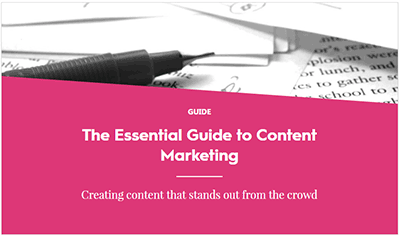Whether it’s setting up your next digital marketing campaign, or building your new website, users need to be at the centre of your thinking – content is no different.
I’ve written previously about how to make your content more user friendly, which includes some practical tips that you might find helpful.
In this article, I want to talk more specifically about how user research and having a better understanding of your audience can help us to create content – and allow us to make more of the content we already have.
Getting in front of users earlier
We often hear from clients that they want to get in front of their users earlier in the consideration process. That means not just having customers or prospects come to them when they are ready to buy, but getting in front of them when they are making their initial enquiries and asking questions about what they need, rather than coming to your website with a solution in mind.
Why is that important? Simply put, it allows us to shape a user’s thinking. It means we have the ability to contribute to their understanding of how to solve the problem.
It’s a challenge we face internally. Prospects often come to us wanting to improve their organic rankings, therefore believing they need SEO. Or perhaps they want more leads or sales, so they believe they need a direct response channel like PPC or email.
In some cases, these aren’t the right solutions and it might be too late for us to provide them with what they really need – content that is shaped around user behaviours and needs throughout the consideration and purchasing journey.
Responding to their challenge
The key here is to base your content around your user’s challenges, rather than responding to a product query. User research is vital here, because it will help you to understand what those challenges are.
Surveys, telephone interviews, face-to-face interviews – all these methods provide varying levels of insight into your users’ behaviours and challenges. Such research can help you to identify where content may play a role in allaying fears, removing pain points and solving users’ problems.
Keyword research can also help here – what are the kinds of searches being made by people who have that challenge? What kind of content could you write that would answer that question and therefore rank for that enquiry?
Make sure you’re talking about the challenge in a way that syncs up with how you would go about solving it. You can talk about your products or services, but don’t go too hard on the sell – remember, you’re trying to help the user understand their challenge. The preferred outcome is that they see you not just as a service provider, but as someone that is helping them resolve whatever frustration they’re dealing with.
As always, include calls to action. That might mean ending with a suggestion to call you to discuss this particular problem, or you could send them off to a service or product page – though you need to be cautious about including anything that feels like a hard sell.
The best option might be to send them to more content – if possible something more in-depth, like a whitepaper or webinar where there might be an opportunity to collect their data for future marketing purposes.
Different content for different people
Another important thing to consider is that within your audience there will be different kinds of people. At the most basic level, you might have the divide between decision makers and influencers.
For example, for a piece of B2B software you are likely to have a difference between a decision maker – so a manager or director – and the person who will be using the service. The person using the service might be consulted by the decision maker, so they’re still valuable to you even if they do not hold the purse strings.
These people might have different needs and different concerns. That doesn’t necessarily mean you need completely different content, it might instead mean you need that content in a different medium.

In this case, a whitepaper is perfect for the end-user – they want knowledge and expertise, and to understand specifically how the software can help them. However, a knowledge heavy, detailed document is going to be a complete turn off for the director or manager. They are unlikely to be willing to commit the time needed to consume that kind of content.
That doesn’t mean the whitepaper is wasted though. Take the key points and boil it down into something shorter and easier to consume – a video or infographic for example.
That means when the end-user reads the whitepaper and recommends the software to the decision maker; they can then view a shorter, punchier format that will help them understand why the end-user thinks your product or service is valuable.
Deeper understanding leads to better results
Having a better understanding of your audience allows you to develop a more intricate and efficient content strategy.
Simply knowing they are interested in your product isn’t enough. You need to understand the challenges that have led them to you in the first place, and then you need to understand the different groups that sit within that audience – and how that affects the kind of content that they are going to be prepared to consume.
This then allows you to build out a content strategy that not only gets in front of users earlier by addressing the challenges they are looking to solve, but also provides the necessary types of content for all of the key users within that audience.
Let’s talk about content strategy
User research is integral to everything we do here at Coast Digital – when it comes to building out a content strategy, we know that having a deep understanding of your audience is vital.
If you’re looking to build out a content strategy, or get a better understanding of the kind of content that will to speak to your audience earlier, then we’d love to help.
Pick up the phone and let’s have a conversation about how user research can help you build out a more effective content marketing strategy… or if you’re not quite there yet, then you can download our free guide, The Essential Guide to Content Marketing.

